Kenwood NX-320, NX-420, NX-220 User Manual

NX-220
NX-320
NX-420
INSTRUCTION MANUAL MODE D’EMPLOI
MANUAL DE INSTRUCCIONES
B62-2470-10 (K)


VHF DIGITAL TRANSCEIVER
NX-220
UHF DIGITAL TRANSCEIVER
NX-320
800MHz DIGITAL TRANSCEIVER
NX-420
Instruction Manual
The AMBE+2TM voice coding Technology embodied in this product is protected by intellectual property rights including patent rights, copyrights and trade secrets of Digital Voice Systems, Inc. This voice coding Technology is licensed solely for use within this Communications Equipment. The user
of this Technology is explicitly prohibited from attempting to extract, remove, decompile, reverse engineer, or disassemble the Object Code, or in any other way convert the Object Code into a human-readable form. U.S. Patent Nos. #6,199,037, #6,912,495, #8,200,497, #7,970,606, and #8,359,197.
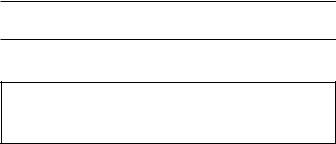
THANK YOU
We are grateful you have chosen KENWOOD for your land mobile radio applications.
This instruction manual covers only the basic operations of your NEXEDGE portable radio. Ask your dealer for information on any customized features they may have added to your radio.
NOTICES TO THE USER
Government law prohibits the operation of unlicensed radio transmitters within the territories under government control.
Illegal operation is punishable by fine and/or imprisonment.
Refer service to qualified technicians only.
Safety: It is important that the operator is aware of, and understands, hazards common to the operation of any transceiver.
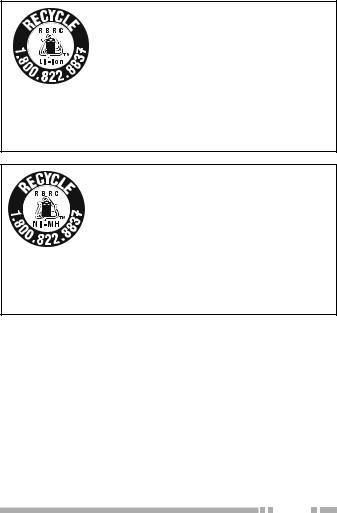
ATTENTION:
The RBRC Recycle seal found on KENWOOD
lithium-ion (Li-ion) battery packs indicates
KENWOOD’s voluntary participation in an industry
program to collect and recycle Li-ion batteries after
their operating life has expired. The RBRC program is an alternative to disposing Li-ion batteries with your regular refuse or in municipal waste streams, which is illegal in some areas.
For information on Li-ion battery recycling in your area, call (toll free) 1-800-8-BATTERY (1-800-822-8837).
KENWOOD’s involvement in this program is part of our commitment to preserve our environment and conserve our natural resources.
ATTENTION:
The RBRC Recycle seal found on KENWOOD nickel metal hydride (Ni-MH) battery packs indicates
KENWOOD’s voluntary participation in an industry
program to collect and recycle Ni-MH batteries after
their operating life has expired. The RBRC program is
an alternative to disposing Ni-MH batteries with your regular refuse or in municipal waste streams, which is illegal in some areas.
For information on Ni-MH battery recycling in your area, call (toll free) 1-800-8-BATTERY (1-800-822-8837).
KENWOOD’s involvement in this program is part of our commitment to preserve our environment and conserve our natural resources.
i

TERMINAL DESCRIPTIONS
Speaker/ Microphone Jacks
You can use a resin-based cover for the Speaker/ Microphone jacks.
No. |
Name |
Description |
Impedance |
I/O |
|
|
|
|
|
1 |
PTT/RXD |
PTT input / Serial data input |
10 k |
I |
|
|
|
|
|
2 |
MICI |
MIC input |
1.8 k |
I |
|
|
|
|
|
3 |
MICO |
Output from internal MIC |
− |
O |
|
|
|
|
|
4 |
OPTDET |
Option Detect |
74 k |
I |
|
|
|
|
|
5 |
50V |
5V output |
− |
O |
|
|
|
|
|
6 |
AE |
Audio Earth |
GND |
− |
|
|
|
|
|
7 |
TXD |
Serial data output |
6.8 k |
O |
|
|
|
|
|
8 |
SPI |
To internal SP |
8 (Load) |
I |
|
|
|
|
|
9 |
SPO |
AF power output |
− |
O |
|
|
|
|
|
Antenna Terminal
50 impedance
ii

One or more of the following statements may be applicable:
FCC WARNING
This equipment generates or uses radio frequency energy. Changes or modifi cations to this equipment may cause harmful interference unless the modifi cations are expressly approved in the instruction manual. The user could lose the authority to operate this equipment if an unauthorized change or modifi cation is made.
INFORMATION TO THE DIGITAL DEVICE USER REQUIRED BY THE FCC
This equipment has been tested and found to comply with the limits for a Class B digital device, pursuant to Part 15 of the FCC Rules. These limits are designed to provide reasonable protection against harmful interference in a residential installation.
This equipment generates, uses and can generate radio frequency energy and, if not installed and used in accordance with the instructions, may cause harmful interference to radio communications. However, there is no guarantee that the
interference will not occur in a particular installation. If this equipment does cause harmful interference to radio or television reception, which can be determined by turning the equipment off and on, the user is encouraged to try to correct the interference by one or more of the following measures:
•Reorient or relocate the receiving antenna.
•Increase the separation between the equipment and receiver.
•Connect the equipment to an outlet on a circuit different from that to which the receiver is connected.
•Consult the dealer for technical assistance.
iii
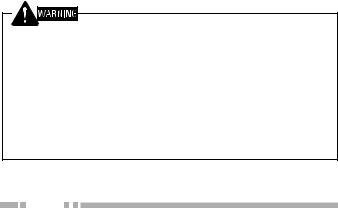
PRECAUTIONS
•Do not charge the transceiver and battery pack when they are wet.
•Ensure that there are no metallic items located between the transceiver and the battery pack.
•Do not use options not specifi ed by KENWOOD.
•If the die-cast chassis or other transceiver part is damaged, do not touch the damaged parts.
•If a headset or headphone is connected to the transceiver, reduce the transceiver volume. Pay attention to the volume level when turning the squelch off.
•Do not place the microphone cable around your neck while near machinery that may catch the cable.
•Do not place the transceiver on unstable surfaces.
•Ensure that the end of the antenna does not touch your eyes.
•When the transceiver is used for transmission for many hours, the radiator and chassis will become hot. Do not touch these locations when replacing the battery pack.
•Always switch the transceiver power off before installing optional accessories.
•The charger is the device that disconnects the unit from the AC mains line. The AC plug should be readily accessible.
Turn the transceiver power off in the following locations:
•In explosive atmospheres (inflammable gas, dust particles, metallic powders, grain powders, etc.).
•While taking on fuel or while parked at gasoline service stations.
•Near explosives or blasting sites.
•In aircrafts. (Any use of the transceiver must follow the instructions and regulations provided by the airline crew.)
•Where restrictions or warnings are posted regarding the use of radio devices, including but not limited to medical facilities.
•Near persons using pacemakers.
iv

•Do not disassemble or modify the transceiver for any reason.
•Do not place the transceiver on or near airbag equipment while the vehicle is running. When the airbag inflates, the transceiver may be ejected and strike the driver or passengers.
•Do not transmit while touching the antenna terminal or if any metallic parts are exposed from the antenna covering. Transmitting at such a time may result in a high-frequency burn.
•If an abnormal odor or smoke is detected coming from the transceiver, switch the transceiver power off immediately, remove the battery pack from the transceiver, and contact your KENWOOD dealer.
•Use of the transceiver while you are driving may be against traffic laws. Please check and observe the vehicle regulations in your area.
•Do not expose the transceiver to extremely hot or cold conditions.
•Do not carry the battery pack with metal objects, as they may short the battery terminals.
•Danger of explosion if the battery is incorrectly replaced; replace only with the same type.
•When operating the transceiver in areas where the air is dry, it is easy to build up an electric charge (static electricity). When using an earphone accessory in such conditions, it is possible for the transceiver to send an electric shock through the earphone and to your ear. We recommend you use only a speaker/microphone in these conditions, to avoid electric shocks.
•When attaching a commercial strap to the transceiver, ensure that the strap is durable. In addition, do not swing the transceiver
around by the strap; you may inadvertently strike and injure another person with the transceiver.
v

Information concerning the battery pack:
The battery pack includes fl ammable objects such as organic solvent. Mishandling may cause the battery to rupture producing fl ames or extreme heat, deteriorate, or cause other forms of damage to the battery. Please observe the following prohibitive matters.
•Do not disassemble or reconstruct battery!
The battery pack has a safety function and protection circuit to avoid danger. If they suffer serious damage, the battery may generate heat or smoke, rupture, or burst into fl ame.
•Do not short-circuit the battery!
Do not join the + and – terminals using any form of metal (such as a paper clip or wire). Do not carry or store the battery pack in containers holding metal objects (such as wires, chainnecklace or hairpins). If the battery pack is short-circuited, excessive current will fl ow and the battery may generate heat or smoke, rupture, or burst into fl ame. It will also cause metal objects to heat up.
•Do not incinerate or apply heat to the battery!
If the insulator is melted, the gas release vent or safety function is damaged, or the electrolyte is ignited, the battery may generate heat or smoke, rupture, or burst into fl ame.
•Do not leave the battery near fires, stoves, or other heat generators (areas reaching over 80°C/ 176°F)!
If the polymer separator is melted due to high temperature, an internal short-circuit may occur in the individual cells and the battery may generate heat or smoke, rupture, or burst into fl ame.
•Avoid immersing the battery in water or getting it wet by other means!
If the battery becomes wet, wipe it off with a dry towel before use. If the battery’s protection circuit is damaged, the battery may charge at extreme current (or voltage) and an abnormal chemical reaction may occur. The battery may generate heat or smoke, rupture, or burst into fl ame.
vi

•Do not charge the battery near fires or under direct sunlight!
If the battery’s protection circuit is damaged, the battery may charge at extreme current (or voltage) and an abnormal
chemical reaction may occur. The battery may generate heat or smoke, rupture, or burst into fl ame.
•Use only the specified charger and observe charging requirements!
If the battery is charged in unspecifi ed conditions (under high temperature over the regulated value, excessive high voltage or current over regulated value, or with a remodelled charger), it may overcharge or an abnormal chemical reaction may occur. The battery may generate heat or smoke, rupture, or burst into
flame.
•Do not pierce the battery with any object, strike it with an instrument, or step on it!
This may break or deform the battery, causing a short-circuit.
The battery may generate heat or smoke, rupture, or burst into
flame.
•Do not jar or throw the battery!
An impact may cause the battery to leak, generate heat or smoke, rupture, and/or burst into fl ame. If the battery’s
protection circuit is damaged, the battery may charge at an abnormal current (or voltage), and an abnormal chemical reaction may occur.
•Do not use the battery pack if it is damaged in any way!
The battery may generate heat or smoke, rupture, or burst into
flame.
•Do not solder directly onto the battery!
If the insulator is melted or the gas release vent or safety function is damaged, the battery may generate heat or smoke, rupture, or burst into fl ame.
•Do not reverse the battery polarity (and terminals)!
When charging a reversed battery, an abnormal chemical reaction may occur. In some cases, an unexpected large amount of current may fl ow upon discharging. The battery may generate heat or smoke, rupture, or burst into fl ame.
vii
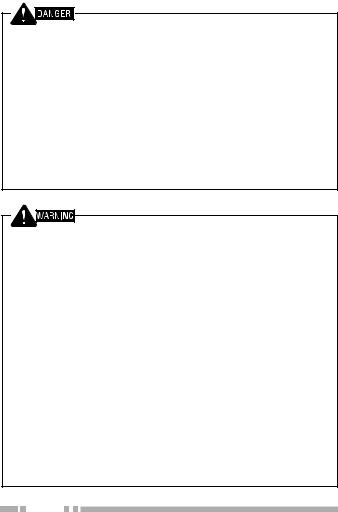
•Do not reverse-charge or reverse-connect the battery!
The battery pack has positive and negative poles. If the battery pack does not smoothly connect with a charger or operating equipment, do not force it; check the polarity of the battery. If the battery pack is reverse-connected to the charger, it will be reverse-charged and an abnormal chemical reaction may occur.
The battery may generate heat or smoke, rupture, or burst into
flame.
•Do not touch a ruptured and leaking battery!
If the electrolyte liquid from the battery gets into your eyes, wash your eyes out with fresh water as soon as possible, without rubbing your eyes. Go to the hospital immediately. If left untreated, it may cause eye-problems.
•Do not charge the battery for longer than the specified time!
If the battery pack has not fi nished charging even after the regulated time has passed, stop it. The battery may generate heat or smoke, rupture, or burst into fl ame.
•Do not place the battery pack into a microwave or high pressure container!
The battery may generate heat or smoke, rupture, or burst into
flame.
•Keep ruptured and leaking battery packs away from fire!
If the battery pack is leaking (or the battery emits a bad odor), immediately remove it from fl ammable areas. Electrolyte leaking from battery can easily catch on fi re and may cause the battery to generate smoke or burst into fl ame.
•Do not use an abnormal battery!
If the battery pack emits a bad odor, appears to have different coloring, is deformed, or seems abnormal for any other reason, remove it from the charger or operating equipment and do not use it. The battery may generate heat or smoke, rupture, or burst into fl ame.
viii
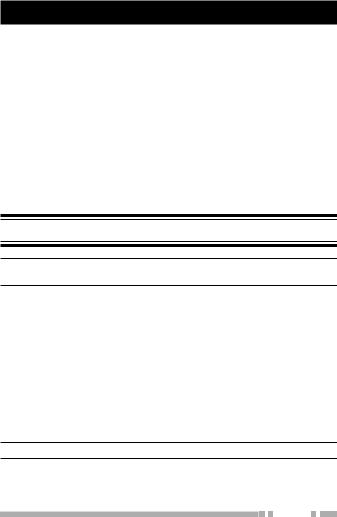
CONTENTS |
|
UNPACKING AND CHECKING EQUIPMENT..................................... |
1 |
PREPARATION .................................................................................... |
2 |
ORIENTATION ..................................................................................... |
6 |
PROGRAMMABLE AUXILIARY FUNCTIONS .................................. |
10 |
BASIC OPERATIONS........................................................................ |
12 |
SCAN ................................................................................................. |
15 |
FleetSync: ALPHANUMERIC 2-WAY PAGING FUNCTION ............. |
17 |
TRUNKING CALLS (ANALOG)......................................................... |
20 |
ADVANCED OPERATIONS ............................................................... |
22 |
BACKGROUND OPERATIONS ......................................................... |
27 |
UNPACKING AND CHECKING EQUIPMENT
Note: These unpacking instructions are for use by your KENWOOD dealer, an authorized KENWOOD service facility, or the factory.
Carefully unpack the transceiver. If any items are missing or damaged, file a claim with the carrier immediately.
SUPPLIED ACCESSORIES |
|
Antenna (NX-420 only) ......................................................................... |
1 |
Belt clip ................................................................................................. |
1 |
Speaker/ microphone jacks cap............................................................ |
1 |
Speaker/ microphone locking bracket................................................... |
1 |
Stopper (types I and II only) ................................................................. |
1 |
Instruction manual ................................................................................ |
1 |
Note: Inquire at your dealer for a stopper. |
|
1

PREPARATION
INSTALLING/ REMOVING THE (OPTIONAL) BATTERY PACK
1 Match the guides of the battery pack with the grooves on the upper rear of the transceiver, then firmly press the battery pack in place.
2 Lock the safety catch to prevent accidentally releasing the battery pack.
3 To remove the battery pack, lift the safety catch, press the release latch, then pull the battery pack away from the transceiver.
Note:
For battery pack charging procedures and useag, refer to the battery charger Instruction Manual.
The battery pack is not charged at the factory; charge it before use.
Before charging a battery pack that is attached to the transceiver, ensure that the safety catch is firmly closed.
INSTALLING/ REMOVING ALKALINE BATTERIES (OPTIONAL BATTERY CASE)
Do not install batteries in a hazardous environment where sparks could cause an explosion.
Never discard batteries in fire; extremely high temperatures can cause batteries to explode.
Do not short circuit the battery case terminals.
Do not use rechargeable batteries.
2
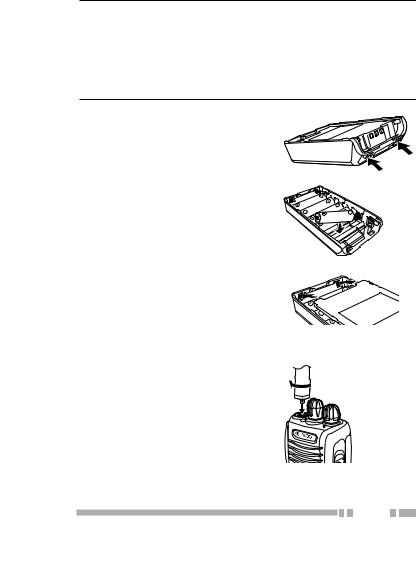
Note:
If you do not plan to use the transceiver for a long period, remove the batteries from the battery case.
This battery case has been designed for transmitting at a power of approximately 1 W (the low power setting on your transceiver). If you want to transmit a stronger signal (using the high power setting on your transceiver), use an optional rechargeable battery pack.
1To open the battery case, press on the two tabs on the upper rear of the case, then pull the two halves apart.
2Insert 6 AA (LR6) Alkaline batteries into the battery case.
•Be sure to match the polarities with those marked in the bottom of the battery case.
3Align the tabs of the cover with the base, then push down on the cover until it locks in place.
INSTALLING THE ANTENNA
Screw the antenna into the connector on the top of the transceiver by holding the antenna at its base and turning
it clockwise until secure.
3
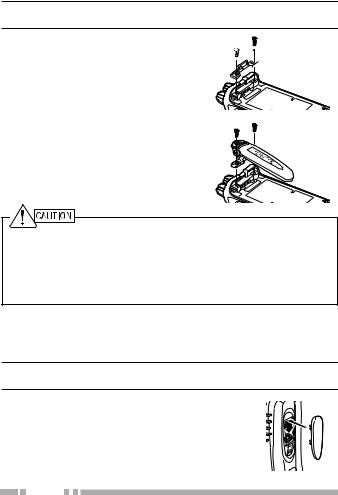
INSTALLING THE BELT CLIP
Note: When first installing the belt clip, you must remove the battery pack from the rear of the transceiver.
1Remove the 2 screws from the rear of the transceiver, then remove the small, plastic black covering that was held in place.
2Insert the belt clip mount into the space on the rear of the transceiver.
3Using the 2 screws, affix the belt clip in place.
 Plastic
Plastic 

 covering
covering
•When the belt clip is not installed, leave the plastic covering in place.
•Do not use glue which is designed to prevent screw loosening when installing the belt clip, as it may cause damage to the transceiver. Acrylic ester, which is contained in these glues, may crack the transceiver’s back panel.
INSTALLING THE CAP OVER THE SPEAKER/ MICROPHONE JACKS
Install the cap over the speaker/ microphone jacks when not using an optional speaker/ microphone.
Note: To keep the transceiver water resistant, you must cover the speaker/ microphone jacks with the supplied cap.
1 Place the cap over the jacks so that the locking tabs insert into the transceiver grooves.
4
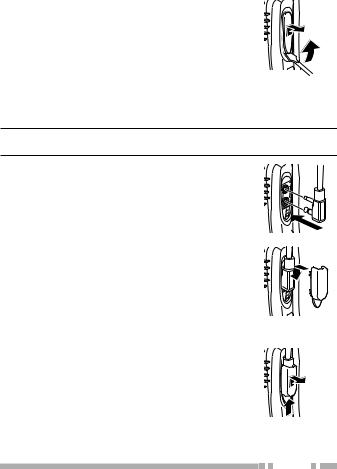
2While holding the cap in place, push it towards the bottom of the transceiver until the tabs on the cap click into place.
• To remove the cap, hold the top of the cap in place with your finger while inserting a
3 mm or smaller flat blade screwdriver under the bottom of the cap. Slowly slide the screwdriver in until its tip touches the tab inside the cap, then gently pry the cap up (handle of screwdriver moving away from the transceiver) to remove the cap.
INSTALLING THE (OPTIONAL) SPEAKER/ MICROPHONE
Note: The transceiver is not fully water resistant when using a speaker/ microphone or headset.
1 Insert the speaker/ microphone plugs into the speaker/ microphone jacks of the transceiver.
2 Place the locking bracket over the speaker/ microphone plugs so that the locking tabs insert into the transceiver grooves.
3 While holding the locking bracket in place, push it towards the bottom of the transceiver until the tabs on the bracket click into place.
•To remove the locking bracket, push the bracket up from the base.
5
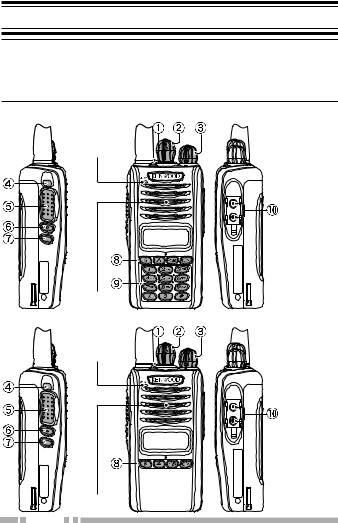
ORIENTATION
There are 3 types of transceivers available: Type I: Equipped with a display and full keypad.
Type II <NX-220/ NX-320 only>: Equipped with a display and 4-key keypad (S, A, <B, and C>).
Type III: Basic model.
Type I
 Antenna
Antenna
Microphone
 Battery pack
Battery pack
Speaker
Type II
 Antenna
Antenna
Microphone
 Battery pack
Battery pack
Speaker
6
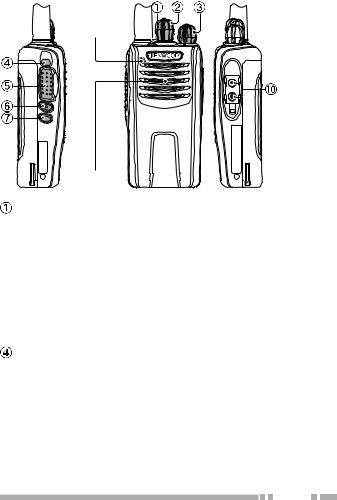
Type III
 Antenna
Antenna
Microphone
 Battery pack
Battery pack
Speaker
Transmit/ Receive/ Battery low indicator
If enabled by your dealer, lights red while transmitting, green while receiving a call (Conventional channels only), and orange when receiving an optional signaling call. Blinks red when the battery power is low while transmitting.
 Selector knob
Selector knob
Rotate to select a zone or channel/group ID (default).
 Power switch/ Volume control
Power switch/ Volume control
Rotate to turn the transceiver ON/OFF and to adjust the volume.
Auxiliary (orange) key
Press to activate its programmable function {page 10}.
 PTT (Push-To-Talk) switch
PTT (Push-To-Talk) switch
Press and hold this switch, then speak into the microphone to call a station.
 Side 1 key
Side 1 key
Press to activate its programmable function {page 10}. The default is [Squelch Off Momentary].
7

Side 2 key
Press to activate its programmable function {page 10}. Types I and II: The default setting is [Backlight]. Type III: The default setting is [None] (no function).
 S, A, <B, C> keys (Types I and II only)
S, A, <B, C> keys (Types I and II only)
Press to activate their programmable functions {page 10}.
S key: The default setting is [None] (no function). A key: The default setting is [None] (no function). <B key: The default setting is [Zone Down].
C> key: The default setting is [Zone Up].
 Keypad (Type I only)
Keypad (Type I only)
Press these keys to send DTMF tones. These keys can also be programmed with secondary functions {page 10} if a programmable function key is programmed as [Function].
 Speaker/ Microphone jacks
Speaker/ Microphone jacks
Insert the Speaker/ Microphone or Headset plug into this jack {page 5}.
8

DISPLAY (TYPES I AND II ONLY)
|
|
|
|
|
|
|
|
|
|
|
|
|
|
|
|
|
|
|
|
|
|
|
|
|
|
|
Indicator |
|
Description |
||||||
Signal strength indicator {page 28}.
Monitor or Squelch Off is activated.
Blinks when an incoming call matches your
Optional Signaling.
Talk Around is activated.
Scan is in progress. Blinks while scan is paused.
A message is stored in memory. Blinks when a new message has arrived.
The current channel is a Priority channel.
The channel is using low transmit power.
Scrambler/ Encryption is activated.
Battery power indicator {page 27}.
The current zone (left icon) or CH/GID (right icon) is added to scan.
VOX is activated.
Not used.
9

PROGRAMMABLE AUXILIARY FUNCTIONS
The Selector, Auxiliary (orange), Side 1, Side 2, S, A, <B, and C> keys, as well as the Keypad, can be programmed with the functions listed below. Please contact your dealer for further details on these functions.
•None
•2-tone 1, 10, 13
•Activity Detection
•Activity Reset
•Autodial 1
•Autodial Programming 1
•Auto Telephone 2
•Backlight 1
•Battery Indicator 3
•Broadcast 4
•Call 1 ~ 6
•CH/GID Down
•CH/GID Recall
•CH/GID Select 5
•CH/GID Up
•Channel Entry 1
•CW Message 6
•Direct CH/GID 1 ~ 5
•Direct CH/GID Select 1 ~ 5
•Display Format 1
•Emergency 7
•Fixed Volume
•Forced Search 4
•Function
•GPS Position Display 1
•Group ID/Channel Entry 1
•Group 1, 6
•Group + Short Message 1, 8
•Group + Status 1, 8
•Home CH/GID
•Home CH/GID Select
•Individual 1, 8
•Individual + Short Message 1, 8
•Individual + Status 1, 8
•Key Lock
•Lone Worker
•Low Transmit Power
•Maintenance 1
•Monitor 9
•Monitor Momentary 9
•Operator Selectable Tone (OST) 1, 10
•Priority-channel Select 1, 11
•Scan
•Scan Delete/Add
•Scrambler/ Encryption
•Selcall 1, 12
•Selcall + Short Message 1, 12
•Selcall + Status 1, 12
•Send the GPS data
•Short Message 1
•Site Down 4
•Site Lock 4
•Site Select 4, 5
•Site Up 4
•Squelch Level 1, 10
•Squelch Off 10
•Squelch Off Momentary 10
•Stack 1
•Status 1
•Talk Around 9
•Telephone Disconnect 2
10

• |
Transceiver Password 1 |
• |
Zone Down |
• |
VOX 11 |
• |
Zone Select 5 |
• |
Zone Delete/Add |
• |
Zone Up |
1Available only for Types I and II.
2Available only for Analog Trunking operation.
3Available only for Type III.
4Available only for NXDN Trunking operation.
5Can be programmed only on the Selector.
6Available only for NXDN Conventional operation.
7Can be programmed only on the Auxiliary (orange) key.
8Available only for NXDN Conventional and NXDN Trunking operation.
9Available only for Analog Conventional, Analog Trunking, and NXDN Conventional operation.
10Available only for Analog Conventional operation.
11Available only for Analog Conventional and NXDN Conventional operation.
12Available only for Analog Conventional and Analog Trunking operation.
13Available only for NX-220/ NX-320.
11

BASIC OPERATIONS
SWITCHING POWER ON/OFF
Turn the Power switch/ Volume control clockwise to switch the transceiver ON.
Turn the Power switch/ Volume control counterclockwise fully to switch the transceiver OFF.
■Transceiver Password (Types I and II Only)
If your transceiver is password protected, you must first enter the password before you can use the transceiver.
1Rotate the Selector to select the first digit of the password.
2Press the S or  key to accept the entry and move to the next digit.
key to accept the entry and move to the next digit.
•Press the A or # key to delete an incorrect digit.
3Repeat steps 1 and 2 to enter the entire password.
•The password can contain a maximum of 6 digits.
4Press the S or  key to confirm the entered password.
key to confirm the entered password.
•If you enter an incorrect password, an error tone sounds and the transceiver remains locked.
ADJUSTING THE VOLUME
Rotate the Power switch/ Volume control to adjust the volume. Clockwise increases the volume and counterclockwise decreases it.
SELECTING A ZONE AND CHANNEL/GROUP ID
Select the desired zone using the key programmed as [Zone Select] or [Zone Up/Down]. Each zone contains a group of channels.
Select the desired channel/group ID using the Selector knob (default). Each channel/group ID is programmed with settings for transmitting and receiving.
12

TRANSMITTING
1Select the desired zone and channel/group ID.
2Press the key programmed as [Monitor] or [Squelch Off] to check whether or not the channel is free.
•If the channel is busy, wait until it becomes free.
3Press the PTT switch and speak into the microphone. Release the PTT switch to receive.
•For best sound quality, hold the transceiver approximately 1.5 inches (3 ~ 4 cm) from your mouth.
■Making Group Calls (Digital) (Types I and II Only)
If a key has been programmed with [Group], you can select a group ID from the list to make a call to those parties on a Conventional channel.
To select a group ID:
1 Press the key programmed as [Group].
2 Press the <B or C> key to select a group ID/name from the list.
3 Press and hold the PTT switch to make the call.
•Speak into the transceiver as you would during a normal transmission.
■Making Individual Calls (Digital) (Types I and II Only)
If a key has been programmed with [Individual], you can make calls to specific persons.
1 Press the key programmed as [Individual].
2 Press the <B or C> key to select a unit ID from the list.
•On Type I models, you can enter a unit ID directly.
3Press and hold the PTT switch to make the call.
•Speak into the transceiver as you would during a normal transmission.
13

RECEIVING
Select the desired zone and channel. If signaling has been programmed on the selected channel, you will hear a call only if the received signal matches your transceiver settings.
Note: Signaling allows your transceiver to code your calls. This will prevent you from listening to unwanted calls. Refer to “SIGNALING” on page 24 for details.
■Receiving Group Calls (Digital)
When you receive a group call on a Conventional channel and the received group ID matches the ID set up on your transceiver, you can hear the caller’s voice.
When you receive a group call on a Trunking channel, the transceiver automatically switches to the communications channel to receive the call.
■Receiving Individual Calls (Digital)
When you receive an individual call, a ringing tone will sound and the caller’s ID will appear on the display (types I and II only). To respond to the call, press and hold the PTT switch and speak into the transceiver as you would during a normal transmission.
14
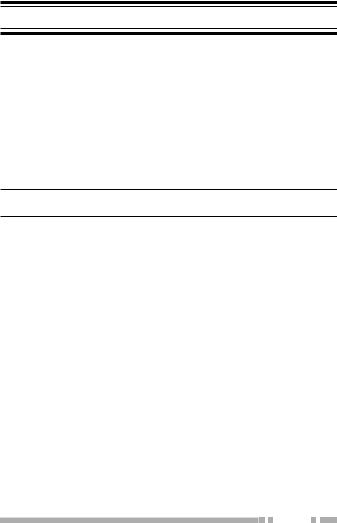
SCAN
Scan monitors for signals on the transceiver channels. While scanning, the transceiver checks for a signal on each channel and only stops if a signal is present.
To begin scanning, press the key programmed as [Scan].
•The  indicator appears (types I and II only).
indicator appears (types I and II only).
•The LED blinks green (type III only).
•When a signal is detected on a channel, Scan pauses at that channel. The transceiver will remain on the busy channel until the signal is no longer present, at which time Scan resumes.
To stop scanning, press the [Scan] key again.
Note: To use Scan, there must be at least 2 channels in the scan sequence.
TEMPORARY CHANNEL LOCKOUT
During scan, you can temporarily remove specific channels from the scanning sequence by selecting them and pressing the key programmed as [Scan Delete/Add].
•The channel is no longer scanned. However, when scanning is ended and restarted, the channels are reset and deleted channels will again be in the scanning sequence.
PRIORITY SCAN
If a Priority channel has been programmed, the transceiver will automatically change to the Priority channel when a call is received on that channel, even if a call is being received on a normal channel.
•The  indicator appears when the selected channel is the Priority channel (depending on dealer setting) (types I and II only).
indicator appears when the selected channel is the Priority channel (depending on dealer setting) (types I and II only).
15

SCAN REVERT
The Scan Revert channel is the channel selected when you press the PTT switch to transmit during scan. Your dealer can program one of the following types of Scan Revert channels:
•Selected: The last channel selected before scan.
•Selected + Talkback: Same as “Selected”, plus you can respond to calls on the channel at which scan is paused.
•Priority: The Priority channel.
•Priority + Talkback: Same as “Priority”, plus you can respond to calls on the channel at which scan is paused.
•Last Called + Selected: The last channel on which you receive a call.
SCAN DELETE/ADD
You can add and remove zones and/or channels/group IDs to and from your scan list.
1Select your desired zone and/or channel/group ID.
2Press the key programmed as [Zone Delete/Add] (to add/ remove zones) or [Scan Delete/Add] (to add/remove channels/group IDs) (types I and II only).
•You can also press and hold the key programmed as [Scan Delete/Add] to add/remove zones.
16

FleetSync: ALPHANUMERIC 2-WAY PAGING FUNCTION
FleetSync is an Alphanumeric 2-way Paging Function, and is a protocol owned by JVC KENWOOD Corporation.
Note: This function is available only in analog operation.
SELCALL (SELECTIVE CALLING)
A Selcall is a voice call to a station or group of stations.
■Transmitting (Types I and II Only)
1 Select your desired zone and channel.
2 Press the key programmed as [Selcall] to enter Selcall mode.
3 Press the <B or C> key to select the station you want to call.
•If Manual Dialing is enabled, you can directly enter the station ID (type I only).
4 Press the PTT switch and begin your conversation.
■Receiving
An alert tone will sound and the transceiver will enter Selcall mode. The calling station’s ID will appear when a Selcall is received (types I and II only). You can respond to the call by pressing the PTT switch and speaking into the microphone.
■Identification Codes
An ID code is a combination of a 3-digit Fleet number and a 4-digit ID number. Each transceiver has its own ID.
• Enter a Fleet number (100 ~ 349) to make a group call.
• Enter an ID number (1000 ~ 4999) to make an individual call in your fleet.
• Enter a Fleet number to make a call to all units in the selected fleet (Fleet call).
17

STATUS MESSAGE (TYPES I AND II ONLY)
You can send and receive 2-digit Status messages which may be decided in your talk group. Messages can contain up to 16 alphanumeric characters. Status messages range from 10 to 99 (80 ~ 99 are reserved for special messages).
A maximum of 15 received messages (combined status messages and short messages) can be stored in the stack memory of your transceiver.
■Transmitting
1 Select your desired zone and channel.
2 Press the key programmed as [Status] to enter Status mode (proceed to step 5) or [Selcall + Status] to enter Selcall mode (proceed to step 3).
3 Press the <B or C> key to select the station you want to call.
•If Manual Dialing is enabled, you can enter a station ID by using the DTMF keypad, or by using the Selector. When using the Selector, cycle through the digits to select a digit, then press the S key to set the digit and move the cursor to the right. Repeat this process until the entire ID is entered.
4Press the S or  key to enter Status mode.
key to enter Status mode.
5Press the <B or C> key to select the status you want to transmit.
•If Manual Dialing is enabled, you can enter a status ID by using the DTMF keypad, or by using the Selector (refer to step 3, above).
6Press the PTT switch or Side 2 key to initiate the call.
•“COMPLETE” appears on the display when the status has been successfully transmitted.
■Receiving
A calling ID or text message will appear when a Status call is received. Press any key to return to normal operation.
18
